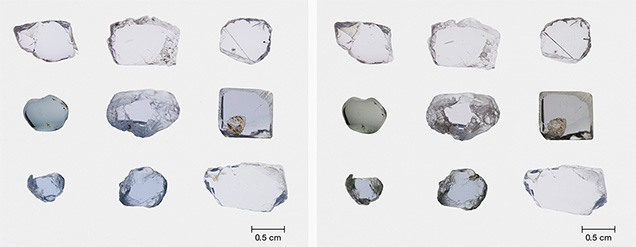Spectroscopic Characteristics of Low-Temperature Heated Blue to Violet Spinel

Although spinel is rarely treated, there have been some heated spinels available in the trade. The effect of heat treatment on pink to red spinel has been previously reported (e.g., S. Saeseaw et al., “Distinguishing heated spinels from unheated natural spinels and from synthetic spinels,” 2009, GIA Research News, https://www.gia.edu/gia-news-research-NR32209A; A. Peretti et al., “Heat-treatment of spinel,” in World of Magnificent Spinels: Provenance and Identification, GRS Gemresearch Swisslab, 2015, pp. 269–278). Chromium-bearing spinel with pink to red color generally becomes darker after heat treatment, and the clarity of spinel containing particulate clouds can be significantly enhanced by heating between approximately 950° and 1150°C (S. Saeseaw et al., 2009).
In addition to the most popular pink to red spinel, another important and desirable variety is blue spinel, especially with a vibrant cobalt blue color. The dominant chromophores in blue to violet spinel includes Fe2+ and Fe3+ at both tetrahedrally (T) and octahedrally (M) coordinated sites of spinel structure as well as Co2+ at the T site (G.B. Andreozzi et al., “Color mechanism in spinel: A multi-analytical investigation of natural crystals with a wide range of coloration,” Physics and Chemistry of Minerals, Vol. 46, 2019, pp. 343–360; V. D’Ippolito et al., “Color mechanism in spinel: Cobalt and iron interplay for the blue color,” Physics and Chemistry of Minerals, Vol. 42, 2015, pp. 431–439). Previous works have revealed the application of cobalt diffusion treatment to enhance blue color in spinel (e.g., S. Saeseaw et al. “GIA lab reports on a new cobalt diffusion treatment of natural spinel,” GIA Research News, 2015, https://www.gia.edu/gia-news-research/cobalt-diffusion-natural-spinel-report). A study on the heat treatment of blue spinel without external chemical diffusion is lacking in the literature, to our knowledge.
To understand the change of chromophores in blue to violet spinel caused by heat treatment, this preliminary study involved exploratory heat treatment of samples from various localities: Madagascar, Myanmar, Tanzania, and Vietnam. The samples were separated into three groups: violet, iron-dominated blue, and cobalt-dominated blue spinel (figure 1, left).

UV-Vis-NIR spectrum of representatives in each group show relatively similar absorption spectra (figure 2), consisting of a strong UV-edge absorption at approximately below 330 nm; multiple absorption bands between 350 and 1100 nm of Fe2+, Fe3+ at T and M sites; and multiple bands between 500 and 670 nm of Co2+ at the T site (Andreozzi et al., 2019; D’Ippolito et al., 2015). With a very similar absorption pattern between violet and blue iron-dominated spinels, the difference in color appearance is associated with different intensity of absorption bands which is more intense in iron-dominated blue spinel due to higher Fe concentrations (Andreozzi et al., 2019). The spinel samples were heated at 600°, 700°, 800°, 900°, and 1000°C in air and held for four hours at each heating temperature. Progressively heating from 600° to 1000°C showed that violet color changed little in this temperature range, whereas blue spinel became more grayish after heating at approximately 800°–900°C (figure 1, right). Heat treatment could affect the color appearance of iron-dominated blue spinel colored much more than cobalt-dominated blue spinel.

After heat treatment (figure 3), the spectra displayed generally broader absorption bands, with less prominent bands below 650 nm and more prominent bands at around 920 nm. The broadening of the chromium emission peak in photoluminescence spectroscopy (PL) is an effective criterion for detecting heat treatment in spinel (e.g., Saeseaw et al., 2009; Peretti et al., 2015). PL spectra of the treated samples in this study were also analyzed and showed that the Cr emission peak of the material broadened after heating at 800°–900°C. The change in color and spectroscopic data after heat treatment resulted from a direct spinel transforming to a partially inverse spinel (R. Widmer et al., “Effects of heat treatment on red gemstone spinel: Single-crystal X-ray, Raman, and photoluminescence study,” Physics and Chemistry of Minerals, Vol. 42, 2015, pp. 251–260) as well as the changes of valence and site distribution of Fe chromophores in the spinel structure. The less desirable blue color of the treated spinel in this preliminary study, regardless of any improvement in clarity, suggests that the heat treatment of the blue to violet spinels was likely unintentional. In addition, as demand for gray colored spinels has increased in the trade over the past few years (Spring 2019 GNI, p.130), some concerns about heat treatment in gray spinels should be raised.



